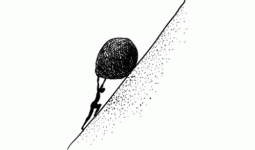-
Happy Premiere of Tchaikovsky's "The Nutcracker" (1892)! 🩰🥥🧚
You are using an out of date browser. It may not display this or other websites correctly.
You should upgrade or use an alternative browser.
You should upgrade or use an alternative browser.
Minn 3 Rebuild
- Thread starter Clint
- Start date
Alan. I sanded with 80 grit the entire boat. Blew off with compressed air, then wiped down with acetone. Let that flash then mixed up thickened epoxy and filled in gouges and a few holes. Where there’s was complete holes we went ahead and patched with 4oz and then immediately covered with a full sheet of 4oz cloth. Rolled on regular mixed epoxy at about 65 degrees room temperature. When we was done I set a heater under the canoe and set it at 80 and left it for the night.
I peeled the glass as far as I think I can. It looks like it has stopped.
I wonder if something in the thickened epoxy could have interfered. Did the area of delamination correspond to one of the patches? If the epoxy for the patch had some surface amine blush, that could cause a problem with the next layer. What kind of epoxy did you use?
This reminds me of the delamination I had on a 1984 kevlar ultralight Wenonah, but in that case the glass I was peeling off had been there for years and I believe the issue was age and/or UV damage to the resin. After I patched it with a full sheet of 5oz kevlar, I put some pretty good knocks on it (in one case enough to break some foam core) and didn't experience any delamination.
- Joined
- Jul 6, 2021
- Messages
- 643
- Reaction score
- 1,174
If everything went right that shouldn’t happen, but there are a lot of things that can go wrong with epoxy and cloth, from improper mixing ratio to amine blush to other incompatibilities.
How much graphite powder in the mix? West 423 graphite powder recommends a max of 10% by volume, or a half tablespoon per 8 fl oz or epoxy. Was it graphite powder made for epoxy work? I know folks have tried graphite powders made for lubrication application or automotive brakes with disastrous results.
How “fresh” was the fiberglass? Glass has “sizing”, a coating that improved adhesion. On old glass the sizing can “age out”. I put a three foot length of old 4” glass tape on the chines of a kayak. A year later it had started to delaminate and the entire strip popped off with a gentle tug.
How long time-wise, hours or days, between that glass work and the water? Some epoxies, epoxy mixes or additives have a long cure time.
How much graphite powder in the mix? West 423 graphite powder recommends a max of 10% by volume, or a half tablespoon per 8 fl oz or epoxy. Was it graphite powder made for epoxy work? I know folks have tried graphite powders made for lubrication application or automotive brakes with disastrous results.
How “fresh” was the fiberglass? Glass has “sizing”, a coating that improved adhesion. On old glass the sizing can “age out”. I put a three foot length of old 4” glass tape on the chines of a kayak. A year later it had started to delaminate and the entire strip popped off with a gentle tug.
How long time-wise, hours or days, between that glass work and the water? Some epoxies, epoxy mixes or additives have a long cure time.
- Joined
- Jul 6, 2021
- Messages
- 643
- Reaction score
- 1,174
Clint, I watched that video again, a couple times.
What strikes me as odd is that the delaminating cloth layer appears fully saturated, graphite black (and black pigment?) through to the bottom of the cloth, but there is not a trace of anything left on the hull as the cloth is peeled off.
That, I guess, has to be a clue of some kind to the adhesion failure, but ???
Mysteries happen. ALSG wrote about recoating the bottom of the stripper he built with a fresh coat of Helmsman Spar Urethane, the same product he had used in the initial build. The new coat of urethane never set up properly.
Helmsman Spar over Helmsman Spar, so it wasn’t product incompatibility. Good prep work, same application technique, done by the same person, so not user error.
I’ve refinished spar urethane with spar urethane dozens of times without any problems. The only explanation I could come up with is that he got a bad can of Helmsman.
What strikes me as odd is that the delaminating cloth layer appears fully saturated, graphite black (and black pigment?) through to the bottom of the cloth, but there is not a trace of anything left on the hull as the cloth is peeled off.
That, I guess, has to be a clue of some kind to the adhesion failure, but ???
Mysteries happen. ALSG wrote about recoating the bottom of the stripper he built with a fresh coat of Helmsman Spar Urethane, the same product he had used in the initial build. The new coat of urethane never set up properly.
Helmsman Spar over Helmsman Spar, so it wasn’t product incompatibility. Good prep work, same application technique, done by the same person, so not user error.
I’ve refinished spar urethane with spar urethane dozens of times without any problems. The only explanation I could come up with is that he got a bad can of Helmsman.
Woodpuppy - Yes all the back the sanded Kevlar. Even has fuzz on the backside of the new epoxy where it tore it off the boat.That’s a bummer. Is the exposed surface the original sanded Kevlar, or the added epoxy layer?
Goonstroke - This spot did not have any patches under it. Just straight cloth to the sanded Kevlar. I used US Composites 635 with medium hardener. Should not of had any blush. As we laid the thicken epoxy patches on. Then immediately laid the new cloth and resin. All with an hour. And it was in the shop in the shade 65 degrees.I wonder if something in the thickened epoxy could have interfered. Did the area of delamination correspond to one of the patches? If the epoxy for the patch had some surface amine blush, that could cause a problem with the next layer. What kind of epoxy did you use?
This reminds me of the delamination I had on a 1984 kevlar ultralight Wenonah, but in that case the glass I was peeling off had been there for years and I believe the issue was age and/or UV damage to the resin. After I patched it with a full sheet of 5oz kevlar, I put some pretty good knocks on it (in one case enough to break some foam core) and didn't experience any delamination.
Mike - Yea. It’s fully saturated,(graphite only no pigment) I do not think what I put on is compromised. I think it is just the bond. Where it is torn from the boat it is clean. All the way back to sanded Kevlar or whatever was left solid on the boat. The pieces even have fuzz on the back side from being torn off. I guess I just did a bad prep job in some areas.Clint, I watched that video again, a couple times.
What strikes me as odd is that the delaminating cloth layer appears fully saturated, graphite black (and black pigment?) through to the bottom of the cloth, but there is not a trace of anything left on the hull as the cloth is peeled off.
That, I guess, has to be a clue of some kind to the adhesion failure, but ???
Mysteries happen. ALSG wrote about recoating the bottom of the stripper he built with a fresh coat of Helmsman Spar Urethane, the same product he had used in the initial build. The new coat of urethane never set up properly.
Helmsman Spar over Helmsman Spar, so it wasn’t product incompatibility. Good prep work, same application technique, done by the same person, so not user error.
I’ve refinished spar urethane with spar urethane dozens of times without any problems. The only explanation I could come up with is that he got a bad can of Helmsman.
The glass was bought new with the epoxy 3/11/2022. Installed on 3/26/2022. First time on the water was 4/14/2022. The graphite was made by Fasco Epoxies. I will confess I got the ratio wrong looking at Mike’s reply. But the coats where just used as topping coats. Not used in the first coat to lay the glass down.
The boat feels strong. And nothing else looks lose. So hopefully it is just a localized incident.
- Joined
- Jul 6, 2021
- Messages
- 643
- Reaction score
- 1,174
“The glass was bought new with the epoxy 3/11/2022. Installed on 3/26/2022. First time on the water was 4/14/2022. The graphite was made by Fasco Epoxies. I will confess I got the ratio wrong looking at Mike’s reply. But the coats where just used as topping coats. Not used in the first coat to lay the glass down”
Clint, thanks, those eliminate any of the likely reasons I could come up with.
15 days should be plenty of time of any epoxy to set up, and I noted that you ran a heater under the hull to keep it warm
The graphite powder, being supplied by an epoxy company, should have been the right stuff, and if the graphite mixed epoxy was just a top coat should have had no effect on the initial glass and epoxy application.
And newly purchased glass eliminates the probability of aged-out sizing, which was my best guess based on past (bad) experience.
We repaired the cracked chines on a friend’s Caribou sea kayak, using 4” E-glass tape on the inside and 2” E-glass tape on the outside. The 2” tape is still attached, but less than a year after we made the repairs the 4” tape on the inside was delaminating, and both three foot long pieces popped off easily.
The funny part with that, before we had laid that cloth he wrote his name in Sharpie where the glass was to be laid, so he would have an un-removable ID in the boat.
Not un-removable; the Sharpie lettering came off with the failed glass, without leaving so much as a trace behind.
That 4” E-glass was ancient, and after that sizing illustration went straight into the trash.
Kudos for confessing and even videotaping a fail. I think there is more to be learned, and shared, from some oopsie, even if from unknown causes, than from builds and rebuilds where everything went exactly as planned.
Clint, thanks, those eliminate any of the likely reasons I could come up with.
15 days should be plenty of time of any epoxy to set up, and I noted that you ran a heater under the hull to keep it warm
The graphite powder, being supplied by an epoxy company, should have been the right stuff, and if the graphite mixed epoxy was just a top coat should have had no effect on the initial glass and epoxy application.
And newly purchased glass eliminates the probability of aged-out sizing, which was my best guess based on past (bad) experience.
We repaired the cracked chines on a friend’s Caribou sea kayak, using 4” E-glass tape on the inside and 2” E-glass tape on the outside. The 2” tape is still attached, but less than a year after we made the repairs the 4” tape on the inside was delaminating, and both three foot long pieces popped off easily.
The funny part with that, before we had laid that cloth he wrote his name in Sharpie where the glass was to be laid, so he would have an un-removable ID in the boat.
Not un-removable; the Sharpie lettering came off with the failed glass, without leaving so much as a trace behind.
That 4” E-glass was ancient, and after that sizing illustration went straight into the trash.
Kudos for confessing and even videotaping a fail. I think there is more to be learned, and shared, from some oopsie, even if from unknown causes, than from builds and rebuilds where everything went exactly as planned.
So todays findings.Kudos for confessing and even videotaping a fail. I think there is more to be learned, and shared, from some oopsie, even if from unknown causes, than from builds and rebuilds where everything went exactly as planned.
The new glass went over to about the 4-5” water line. At that edge I can not get my knife under it and start a delimitation. Also at the bow and stern I added 2 layers of glass to protect them. Also no luck with starting at the edge.
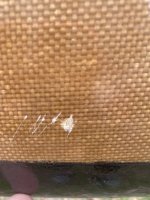
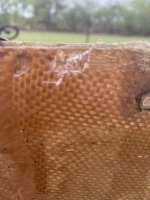
Looking at the pieces that have came off and pulling new ones. There is the grid pattern of Kevlar stuck to the epoxy. Could that be rotten Kevlar? I just did not sand deep enough to get rid of all damaged cloth? Because the new cloth on the side seems to have stuck just fine.
If that is the case. Peel all the new stuff off and sand again? Wait till it peels off? What if I sand it back to the foam?
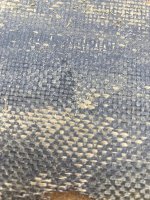
The times I've done repairs like this, I mostly didn't sand to bare kevlar, I just roughed up the resin (vinylester?) enough that there could be some mechanical bond. Broadly speaking, Kevlar is hydrophobic and glass is hydrophilic ... could the glass have more or less sucked the resin off of the kevlar? If the surface of the kevlar is naked and fuzzed, it might be better to paint some epoxy on it, let it cure fully, rough it, and then add glass. I'm obviously speculating as I haven't seen this happen in fresh patches, maybe others here have.
- Joined
- Jul 6, 2021
- Messages
- 643
- Reaction score
- 1,174
“If that is the case. Peel all the new stuff off and sand again? Wait till it peels off?”
I wouldn’t wait for it to peel off on its own after some minor paddling bump or bruise. As making backwards progress as it sounds I would peel off anything I could, even if that meant trying lift an edge with a razor knife to see if it was free-able.
In some ways, if the failed cloth peels off and removes cleanly, you are ahead on the re-repairs. Sanding glass impregnated with graphite powder is a nightmare. If it comes to that I’d do it outside, with a respirator and full PPE garb. You’ll look like a coal miner coming off a long shift when finished sanding.
FWIW this if the strip of failed 4” E-glass that popped off the sea kayak chines.
 DSCF1954 by Mike McCrea, on Flickr
DSCF1954 by Mike McCrea, on Flickr
At least we didn’t need to try to sand it off the angled chines inside the hull; that would have been awkwardly challenging.
I wouldn’t wait for it to peel off on its own after some minor paddling bump or bruise. As making backwards progress as it sounds I would peel off anything I could, even if that meant trying lift an edge with a razor knife to see if it was free-able.
In some ways, if the failed cloth peels off and removes cleanly, you are ahead on the re-repairs. Sanding glass impregnated with graphite powder is a nightmare. If it comes to that I’d do it outside, with a respirator and full PPE garb. You’ll look like a coal miner coming off a long shift when finished sanding.
FWIW this if the strip of failed 4” E-glass that popped off the sea kayak chines.
 DSCF1954 by Mike McCrea, on Flickr
DSCF1954 by Mike McCrea, on FlickrAt least we didn’t need to try to sand it off the angled chines inside the hull; that would have been awkwardly challenging.
Wow, I'm feeling for you Clint. So, it's got to be one of two things, either the surface or the epoxy. Did you say earlier what type of epoxy you used, and its age? I wonder if you somehow got the mixture bad on one batch. Too much hardener??? I accidently used 2 parts hardener to 1 part resin by mistake and the stuff stayed sticky, so I assume that's not what you did. From your video I'm seeing some old stuff coming off with the glass. This could mean that there was a layer of poorly adhered old resin still on the hull in that area. You may have sanded it until it looked good, but it would be difficult to tell. Is there any sign of delamination in any other areas?
Time for a solution. I would flex the hull in other areas and see if you can get any more to delaminate using similar pressure to the stick you ran over, or more! I would even gouge the surface in a few places with something sharp to see if the glass is adhered. Take a sharp scraper to delaminated area and the edge of the glass and see if more will come off. As you know, you can fix just about anything with more glass and epoxy. Hopefully not and the problem is isolated to this one area. If you're satisfied that it's only the one area I would re-sand and either do a test patch in that area or just go for it and re-glass. Keep us posted
Good luck, Mark
Sorry to repeat some of what was said above, for some reason I wasn't seeing the more recent posts.
Time for a solution. I would flex the hull in other areas and see if you can get any more to delaminate using similar pressure to the stick you ran over, or more! I would even gouge the surface in a few places with something sharp to see if the glass is adhered. Take a sharp scraper to delaminated area and the edge of the glass and see if more will come off. As you know, you can fix just about anything with more glass and epoxy. Hopefully not and the problem is isolated to this one area. If you're satisfied that it's only the one area I would re-sand and either do a test patch in that area or just go for it and re-glass. Keep us posted
Good luck, Mark
Sorry to repeat some of what was said above, for some reason I wasn't seeing the more recent posts.
Last edited:
On the bottom it was in such bad shape I had to take it down so far because of whatever the previous owner had put on it. Which I think was "bondo epoxy" from dealing with it in the past. Really hard and brittle. By the time I had it off I was down to the kevlar because the original coating was gone and kevlar was starting to degrade from the sun. When I laid the glass I laid it on dry, positioned it and started rolling on epoxy like you would a strip canoe. It was light fiberglass and never though anything else about it. It wet out really easy and and stuck good.The times I've done repairs like this, I mostly didn't sand to bare kevlar, I just roughed up the resin (vinylester?) enough that there could be some mechanical bond. Broadly speaking, Kevlar is hydrophobic and glass is hydrophilic ... could the glass have more or less sucked the resin off of the kevlar? If the surface of the kevlar is naked and fuzzed, it might be better to paint some epoxy on it, let it cure fully, rough it, and then add glass. I'm obviously speculating as I haven't seen this happen in fresh patches, maybe others here have.
That's crazy how some pieces just pop off for because of the sizing. Perfect sharpie impression!“If that is the case. Peel all the new stuff off and sand again? Wait till it peels off?”
I wouldn’t wait for it to peel off on its own after some minor paddling bump or bruise. As making backwards progress as it sounds I would peel off anything I could, even if that meant trying lift an edge with a razor knife to see if it was free-able.
In some ways, if the failed cloth peels off and removes cleanly, you are ahead on the re-repairs. Sanding glass impregnated with graphite powder is a nightmare. If it comes to that I’d do it outside, with a respirator and full PPE garb. You’ll look like a coal miner coming off a long shift when finished sanding.
FWIW this if the strip of failed 4” E-glass that popped off the sea kayak chines.
At least we didn’t need to try to sand it off the angled chines inside the hull; that would have been awkwardly challenging.
The way it is peeling off clean is the only thing that is helping in this situation.
I feel that the "epoxy" job was done correctly. Because all the other things that was done that day and the whole weekend has been fine. Heck even the same lay up just in a different spot is fine. It has to be the surface above the bad kevlar. It just has to be rotten and there is just nothing for the epoxy to hold to. I do not have time to peel and fix the entire bottom before a race in a couple weekends. So I'm going to patch the spot run the race and see how it fairs. Depending on that outcome will determine the time frame on when the bottom will get redone again.Wow, I'm feeling for you Clint. So, it's got to be one of two things, either the surface or the epoxy. Did you say earlier what type of epoxy you used, and its age? I wonder if you somehow got the mixture bad on one batch. Too much hardener??? I accidently used 2 parts hardener to 1 part resin by mistake and the stuff stayed sticky, so I assume that's not what you did. From your video I'm seeing some old stuff coming off with the glass. This could mean that there was a layer of poorly adhered old resin still on the hull in that area. You may have sanded it until it looked good, but it would be difficult to tell. Is there any sign of delamination in any other areas?
Time for a solution. I would flex the hull in other areas and see if you can get any more to delaminate using similar pressure to the stick you ran over, or more! I would even gouge the surface in a few places with something sharp to see if the glass is adhered. Take a sharp scraper to delaminated area and the edge of the glass and see if more will come off. As you know, you can fix just about anything with more glass and epoxy. Hopefully not and the problem is isolated to this one area. If you're satisfied that it's only the one area I would re-sand and either do a test patch in that area or just go for it and re-glass. Keep us posted
Good luck, Mark
Sorry to repeat some of what was said above, for some reason I wasn't seeing the more recent posts.
Thank you everyone for the replies and helping with solutions to what maybe the problem.
On a different note I was able to get a pedestal built and installed for the center seat.
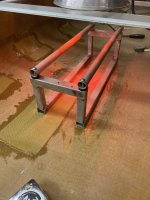
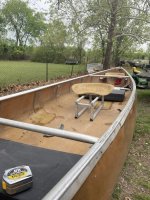
Last edited:
Hopefully the issue stays local and you can just infill. It sure sounds like you dotted your i's and crossed your t's.
Good luck on the Safari! I've never done it but it's on my bucket list. I hear it's tough sledding -- should be a good burn-in test for the new underbelly.
Good luck on the Safari! I've never done it but it's on my bucket list. I hear it's tough sledding -- should be a good burn-in test for the new underbelly.
Alright. Now that the Texas Water Safari is over and I am not running in circles with this boat and getting everything ready. I am going to try and set down and write what all we had to do to this boat to get it ready to race.
I finally figured out what I did to the bottom layers................ I bought the boat........... Short story is I should not have bought it because the Kevlar was rotten.
Here is the long story,
Every time we took the boat out to train in it if we hit something it would damage the boat. Sometimes it was a minor scrape that would result in a delamination like above. Or it could be a major thing like a limb all the way through the boat and almost through my leg.
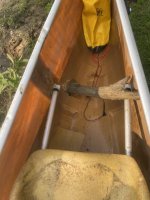
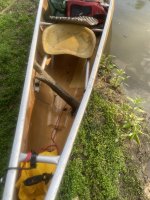
So we kept patching and trying to train in the boat. And in the meantime train in our aluminums. Also we went to our first race in the Min3 now with the nick name “Peanut Brittle” Texas River Marathon to establish our starting position in the Texas Water Safari. We had a good run and finished the race a little slower than what we wanted but it is a low water year so we have to factor that in. The next day since we was already down in the area we paddled another 16 miles of the race course. Finished and loaded up at the truck. And while inspecting the boat we noticed there is a split down the center under the stern seat. With 5 weeks to go till race day I did a little surgery to the boat to try and get us back on the water.
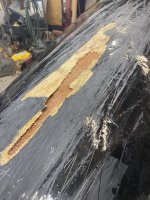
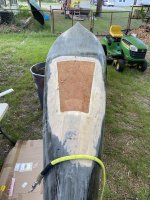
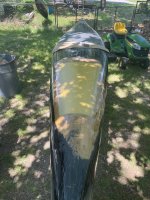
With the boat fixed back up we went down to the race course for the Memorial weekend to paddle 30-40 miles. Day 1 of a 20 mile paddle and with 3 miles left came to a log in the river that we slide up on and we heard a pop! So, pulled over on a gravel bar to inspect the damage. Another crack from the previous repair on up the center of the boat. The pop was the center seat rails coming lose from the bottom. So that ended our trip short and we just came home the next morning.
Now with 2 weeks till race day I needed to order everything and fix it before we left for the race. So broke out the skill saw again. Cut just inside of the foam ribs the complete bottom. Took a heat gun and started pulling the old Kevlar bottom off the boat. My paddling partners that week where off because of school ending so they came over and prepped the boat during the day. Was able to get the Kevlar ordered and to the house by the next weekend. And that Saturday we laid down some cloth. Ended up with 2 layers of 5oz Kevlar and 1 layer of 4oz fiberglass. Then filled with the graphite and epoxy again. After the set up Monday we flipped the boat and laid a 5oz layer of Kevlar inside. Everything had 5 days of cure time in about 90-100f temps before it hit the water.
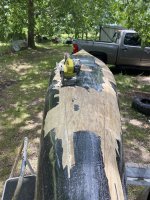
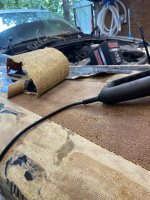
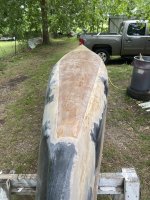
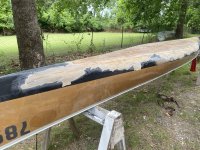
I did not get a picture of the finished bottom. I thought I did but can not find it. In the process of doing the bottom it had become hogged. So I was able to slide a beam inside and strap the canoe down to it and reapply the rocker to the boat. It handled so much better after that.
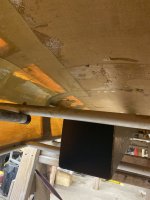
So, I am glad it broke again right before the race. Because if it hadn’t, we would not have finished the race. Also I am glad that I bought the boat because it was a great learning experience. Now if I would have spent a lot of money on the boat in the first place I would not be as happy about it. But it still works out in the end. I just wish I would have realized what was wrong with it in the very beginning and fix it from the start. But now I know. We went on to finish the race. Some race officials are calling it one of the worst years ever. A combination of high winds, high temps and low water levels caused I believe 69 teams to DNF out of 149. We place 42nd overall and 13th in our division.

I finally figured out what I did to the bottom layers................ I bought the boat........... Short story is I should not have bought it because the Kevlar was rotten.
Here is the long story,
Every time we took the boat out to train in it if we hit something it would damage the boat. Sometimes it was a minor scrape that would result in a delamination like above. Or it could be a major thing like a limb all the way through the boat and almost through my leg.


So we kept patching and trying to train in the boat. And in the meantime train in our aluminums. Also we went to our first race in the Min3 now with the nick name “Peanut Brittle” Texas River Marathon to establish our starting position in the Texas Water Safari. We had a good run and finished the race a little slower than what we wanted but it is a low water year so we have to factor that in. The next day since we was already down in the area we paddled another 16 miles of the race course. Finished and loaded up at the truck. And while inspecting the boat we noticed there is a split down the center under the stern seat. With 5 weeks to go till race day I did a little surgery to the boat to try and get us back on the water.



With the boat fixed back up we went down to the race course for the Memorial weekend to paddle 30-40 miles. Day 1 of a 20 mile paddle and with 3 miles left came to a log in the river that we slide up on and we heard a pop! So, pulled over on a gravel bar to inspect the damage. Another crack from the previous repair on up the center of the boat. The pop was the center seat rails coming lose from the bottom. So that ended our trip short and we just came home the next morning.
Now with 2 weeks till race day I needed to order everything and fix it before we left for the race. So broke out the skill saw again. Cut just inside of the foam ribs the complete bottom. Took a heat gun and started pulling the old Kevlar bottom off the boat. My paddling partners that week where off because of school ending so they came over and prepped the boat during the day. Was able to get the Kevlar ordered and to the house by the next weekend. And that Saturday we laid down some cloth. Ended up with 2 layers of 5oz Kevlar and 1 layer of 4oz fiberglass. Then filled with the graphite and epoxy again. After the set up Monday we flipped the boat and laid a 5oz layer of Kevlar inside. Everything had 5 days of cure time in about 90-100f temps before it hit the water.




I did not get a picture of the finished bottom. I thought I did but can not find it. In the process of doing the bottom it had become hogged. So I was able to slide a beam inside and strap the canoe down to it and reapply the rocker to the boat. It handled so much better after that.

So, I am glad it broke again right before the race. Because if it hadn’t, we would not have finished the race. Also I am glad that I bought the boat because it was a great learning experience. Now if I would have spent a lot of money on the boat in the first place I would not be as happy about it. But it still works out in the end. I just wish I would have realized what was wrong with it in the very beginning and fix it from the start. But now I know. We went on to finish the race. Some race officials are calling it one of the worst years ever. A combination of high winds, high temps and low water levels caused I believe 69 teams to DNF out of 149. We place 42nd overall and 13th in our division.

Nice work on the Safari! It's absolutely amazing that that boat survived it, after all those late day radical repairs and low water to boot. I've never seen a canoe re-bottomed that way -- bold.
That tree limb photo is awesome. Wenonah's classic kevlar ultralight layup is not exactly bombproof even when it's virginal, and the breach usually ends up right in front of a rib. Maybe you need to wear shin guards!
That tree limb photo is awesome. Wenonah's classic kevlar ultralight layup is not exactly bombproof even when it's virginal, and the breach usually ends up right in front of a rib. Maybe you need to wear shin guards!
goonstroke - Thank you! We where also surprised at how well it held together. I was not sure how else to do the bottom without it falling apart. I am not scared to do it again and will say that the boat is bullet proof now. I'll take it anywhere. To add to the stress test, we crossed the bay at the end of the race. Two crossing one about 3 miles and another 1.5 miles with 3-4 waves. Handled it great, I was worried with that much torque on the complete boat going over the crest and valleys it would fine the weak spots and work it apart. With all we did to it, it added 17lbs. If I did it again I would peel the inside off also to save on some weight. We was running out of time and could not afford the time to take it our on this one.Nice work on the Safari! It's absolutely amazing that that boat survived it, after all those late day radical repairs and low water to boot. I've never seen a canoe re-bottomed that way -- bold.
That tree limb photo is awesome. Wenonah's classic kevlar ultralight layup is not exactly bombproof even when it's virginal, and the breach usually ends up right in front of a rib. Maybe you need to wear shin guards!
- Joined
- Jul 6, 2021
- Messages
- 643
- Reaction score
- 1,174
“Every time we took the boat out to train in it if we hit something it would damage the boat. Sometimes it was a minor scrape that would result in a delamination like above. Or it could be a major thing like a limb all the way through the boat and almost through my leg”
Clint, there are some scary canoe photos, starting on post 1 and throughout your rebuild, none more so than that hull poking log. I’d love to know your exact words when it burst through at your legs.
I gotta ask, did Peanut Brittle spend its previous life baking fully exposed to the hot Texas sun?
The very first canoe I ever repaired was a hull that came out of south Texas. It had lived a sun rich life and was likewise brittle. Much like your Minn III I repaired it, re-repaired it and re-re-repaired it, admittedly not skillfully from the start (auto store glass and poly resin, jagged gunwales covered with slit garden hose, adhered with construction adhesive, leftover spray paint over repairs, not always the same color spray paint), and mostly used it as a loaner canoe on group trip gentle water trips.
I was always concerned that someone would stand up in it and go full Flintstones car-style, stuck half way through the hull from the waist down.
It was not a pretty canoe. Its last group trip saw it racked on my rusty old truck and driven to a put in some hours away by a visiting Aussie couple. When we all got to the put in they immediately remarked “American drivers really like to honk and wave”
Before they left my driveway I had surreptitiously attached a sign to the tailgate
POOR WHITE TRASH CANOE CLUB
That sign was around longer than the canoe; it would reappear stuck on someone’s vehicle from trip to trip. I got it back at least once.
I finally gave that canoe to a guy with a couple young sons, with the caveat that it was free because it was brittle untrustworthy. It never sunk on him, or even cracked further, and he got a few years out of it before buying a better canoe. IIRC he wisely cut it up and took it to the dump, which saved me the trouble of doing so.
Please keep us posted on the continuing adventures of Peanut Brittle.
Clint, there are some scary canoe photos, starting on post 1 and throughout your rebuild, none more so than that hull poking log. I’d love to know your exact words when it burst through at your legs.
I gotta ask, did Peanut Brittle spend its previous life baking fully exposed to the hot Texas sun?
The very first canoe I ever repaired was a hull that came out of south Texas. It had lived a sun rich life and was likewise brittle. Much like your Minn III I repaired it, re-repaired it and re-re-repaired it, admittedly not skillfully from the start (auto store glass and poly resin, jagged gunwales covered with slit garden hose, adhered with construction adhesive, leftover spray paint over repairs, not always the same color spray paint), and mostly used it as a loaner canoe on group trip gentle water trips.
I was always concerned that someone would stand up in it and go full Flintstones car-style, stuck half way through the hull from the waist down.
It was not a pretty canoe. Its last group trip saw it racked on my rusty old truck and driven to a put in some hours away by a visiting Aussie couple. When we all got to the put in they immediately remarked “American drivers really like to honk and wave”
Before they left my driveway I had surreptitiously attached a sign to the tailgate
POOR WHITE TRASH CANOE CLUB
That sign was around longer than the canoe; it would reappear stuck on someone’s vehicle from trip to trip. I got it back at least once.
I finally gave that canoe to a guy with a couple young sons, with the caveat that it was free because it was brittle untrustworthy. It never sunk on him, or even cracked further, and he got a few years out of it before buying a better canoe. IIRC he wisely cut it up and took it to the dump, which saved me the trouble of doing so.
Please keep us posted on the continuing adventures of Peanut Brittle.
I think my words was something like "OH $HIT!" as it was picking me up and rolling me out the back of my seat. Had a big goose egg on the bottom of the leg for about a week. Made it tinder to sit in the office chair for the next day.“Every time we took the boat out to train in it if we hit something it would damage the boat. Sometimes it was a minor scrape that would result in a delamination like above. Or it could be a major thing like a limb all the way through the boat and almost through my leg”
Clint, there are some scary canoe photos, starting on post 1 and throughout your rebuild, none more so than that hull poking log. I’d love to know your exact words when it burst through at your legs.
I believe it did. When I went to do look at it we took it off of a rack outside. And of course it was on top.I gotta ask, did Peanut Brittle spend its previous life baking fully exposed to the hot Texas sun?
That would be an easy way to portage the boat maybe. Put some heavy duty suspenders on it.I was always concerned that someone would stand up in it and go full Flintstones car-style, stuck half way through the hull from the waist down.
AMEN !!!Late to this thread. Clint, for this legendary effort worthy of the Greek gods . . .
View attachment 131976
. . . you get the rare CanoeTripping Sisyphus Award statue.
View attachment 131977
Similar threads
- Replies
- 10
- Views
- 2K
- Replies
- 43
- Views
- 10K

